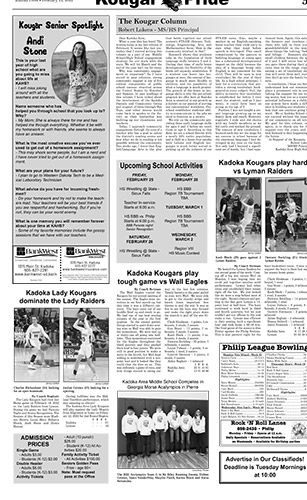What a year this has been! The writing today is my last column of February. It seems like just yesterday that I started writing this column as a part of our Middle School/High School engagement strategy for our work with the state. We will hit March, and the end of the year isn’t too far away. Why was community engagement so important? As I have stated in past columns, strong community support is one of five critical components of public-school success observed across the United States by Horsford and Samson. In past readings of this column, I have talked about the involvement of the Kadoka Parents and Community Group and support of them through Box Tops, and other means would come back in spades to the district as their leadership was building up our classrooms and teachers.
Today, I approach community engagement through the eyes of a teacher who has a goal to salute the district’s reading scores and how what we do in reading is not possible without the community. Two weeks ago, I wrote that English/Language Arts is the glue that holds together our school system’s STEAM (Science, Technology, Engineering, Arts, and Mathematics) focus. How is the community involved in that?
Research shows that students take in the foundation of their language skills between 2 and 4. During that time of early brain development, the flexibility of the brain cell capacity establishes. If a student can learn two languages at once, the concept of language is much more flexible to children, and the possibility of what a language is much greater. The growth of the brain in language skills is why the pre-school program we offer here at Kadoka Area is essential to our growth as a district in our pursuit of serving our community’s workforce. Preschool establishes students’ ability to communicate in the jobs we need to function as a society.
We rely on the community providing these early language skills for ages 2 and 3 before we reach them at age 4. According to this data, we are a school district with a nearly 50% native population, and a child in a home that speaks both Lakota and English languages is much better served in picking up all the subjects of our STEAM cores. Also, maybe a mother in an English-speaking home teaches their child early to sign what they want before speech is developed. This small commitment by the parents to building language at young ages has a substantial developmental impact on the child because the idea of a language being only English is not cemented for the child. They will be open to new vocabulary for the rest of their life. As a high school principal, I look for a curriculum that provides a strong vocabulary background in every subject. Still, the ability to receive that vocabulary is established far before I ever meet the student, and as I just wrote, it could have been as young as the age of 2.
Further, I was not taught a second language growing up on my family farm and ranch. However, regularly I rode and did chores with my family members as we fed cattle and worked on the ground. The amount of new vocabulary I learned each day set the stage for my success in school because of the enormous language I developed on my time on the farm. Not only had I learned a significant set of words, but I had experienced them. Again, this salutes the farmers and ranchers out there who talk to their young grandchild/child in the tractor about things like ‘calving,’ ‘bales,’ and ’tillage. Research shows small children between the ages of 2 and 5 will never lose what you gave them during their precious time on the range, experiencing a set of vocabulary skills that will serve them well, even if they don’t go into the family business.
In conclusion, I hope you better understand how our community plays a prominent role in establishing the support for our reading scores, how you as a reader, a potential influence on a child, in our system have made a difference in building our students and how that can continue going forward. We at Kadoka School cannot succeed without the support of our community on all levels. My goal for this column, once again, is to thank you for that support over the years, and we look forward to that happening in the future.
In Support of the Kougars,
Robert Lukens MS/HS Principal
Kadoka Area High School

